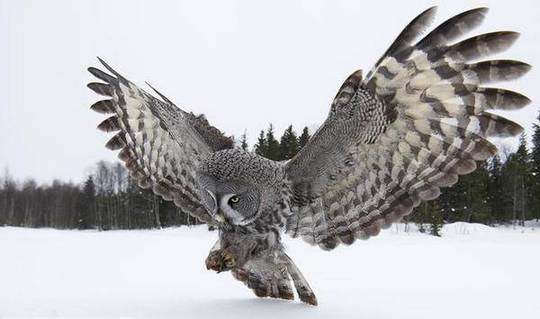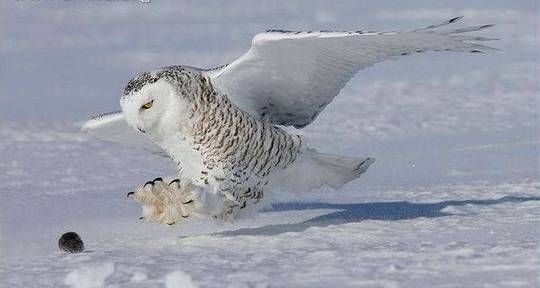Owls are a Group of Birds that belong to the order Strigiformes, constituting 200 extant bird of Prey Species.
They are found in all regions of the Earth except Antarctica, most of Greenland and some remote islands.
Most owls are Nocturnal, Actively Hunting their Prey only in Water and Darkness.
Several types of Owl, however, are Crepuscular – active during the Twilight Hours of Dawn and Dusk.
An Owl’s Sharp Beak and Powerful Talons allow it to kill its Prey before swallowing it whole (if it is not too big).
They are found in all regions of the Earth except Antarctica, most of Greenland and some remote islands.
Most owls are Nocturnal, Actively Hunting their Prey only in Water and Darkness.
Several types of Owl, however, are Crepuscular – active during the Twilight Hours of Dawn and Dusk.
An Owl’s Sharp Beak and Powerful Talons allow it to kill its Prey before swallowing it whole (if it is not too big).
The Largest Owl By Length is the Great Grey Owl, which measures around 70 cm (28 in) on average and can attain a length of 84 cm (33 in).
However, The Heaviest and Largest Winged Owls are two similarly-sized Eagle Owls — The Eurasian Eagle-Owl and The Blakiston’s Fish Owl .
These two Species, which are on average about 2.53 cm (1.00 in) shorter in length than The Great Grey, can both attain a wingspan of 2 m (6.6 ft) and a weight of 4.5 kg (10 lb) in the largest females.

The Eurasian Eagle-Owl is one of the largest owls in the world. They favor rocky outcrops and cliffs in a variety of wooded habitats throughout much of Europe and Asia.

This owl mainly eats mammals, but will also hunt birds, amphibians, reptiles, fish, and insects.

Eurasian Eagle-Owls usually hunt at night from a perch, or while flying low over the ground or tree-tops.Prey is captured on the ground, in the air, or after plunging into water.

Eurasian Eagle-Owls prefer to nest on ledges, in cave entrances, and within rock crevices on cliffs. They will sometimes use the abandoned nests of other large raptors.
The female lays 2 – 4 eggs that are incubated for 34 – 36 days. The young owls fledge at about 7 weeks of age, but the parents tend the fledglings for another 3 – 4 months. This owl becomes sexually mature at 2 – 3 years.

The Great Grey Owl or Lapland Owl is a very large owl, distributed across the Northern Hemisphere. In some areas it is also called the Great Gray Ghost or Phantom of the north. This owl does not have ear tufts and has the largest facial disc of any raptor.

Their breeding habitat is the dense coniferous forests of the taiga, near open areas, such as meadows or bogs. Great Grey Owls do not build nests, so typically use nests previously used by a large bird, such as a raptor. They will also nest in broken-topped trees and cavities in large trees. Nesting may occur from March to May. Four eggs are the usual clutch size.

These birds wait, listen, and watch for prey, then swoop down; they also may fly low through open areas in search of prey. Their large facial disks, also known as “ruffs”, focus sound, and the asymmetrical placement of their ears assists them in locating prey, because of the lack of light during the late and early hours in which they hunt.

On the nesting grounds, they mainly hunt at night and near dawn and dusk; at other times, they are active mostly during the night. They have excellent hearing, and may locate (and then capture) prey moving beneath 60 cm (2 feet) of snow in a series of tunnels solely with that sense.

The call of the adult is a series of very deep, rhythmic whoos, which is usually given in correlation to their territories or in interactions with their offspring. At other times, adults are normally silent. The young may chatter, shriek or hiss.

The Snowy Owls (Body, 20 to 28 in (52 to 71 cm); wingspan, 4.2 to 4.8 ft (1.3 to 1.5 m Weight:3.5 to 6.5 lbs (1.6 to 3 kg)) breed on the Arctic tundra, where females lay a clutch of 3 to 11 eggs.

Clutch size depends upon the availability of food, and in particularly lean times a usually monogamous pair of owls may not breed at all. Females are darker than males, with dusky spotting, and never become totally white.

The snowy owl is a patient hunter that perches and waits to identify its prey before soaring off in pursuit. Snowy owls have keen eyesight and great hearing, which can help them find prey that is invisible under thick vegetation or snowcover.

The owls deftly snatch their quarry with their sharp talons. A snowy owl’s preferred meal is lemmings—many lemmings.

An adult may eat more than 1,600 lemmings a year, or three to five every day.
However, The Heaviest and Largest Winged Owls are two similarly-sized Eagle Owls — The Eurasian Eagle-Owl and The Blakiston’s Fish Owl .
These two Species, which are on average about 2.53 cm (1.00 in) shorter in length than The Great Grey, can both attain a wingspan of 2 m (6.6 ft) and a weight of 4.5 kg (10 lb) in the largest females.
1. Eurasian Eagle Owl

The Eurasian Eagle-Owl is one of the largest owls in the world. They favor rocky outcrops and cliffs in a variety of wooded habitats throughout much of Europe and Asia.

This owl mainly eats mammals, but will also hunt birds, amphibians, reptiles, fish, and insects.

Eurasian Eagle-Owls usually hunt at night from a perch, or while flying low over the ground or tree-tops.Prey is captured on the ground, in the air, or after plunging into water.

Eurasian Eagle-Owls prefer to nest on ledges, in cave entrances, and within rock crevices on cliffs. They will sometimes use the abandoned nests of other large raptors.
The female lays 2 – 4 eggs that are incubated for 34 – 36 days. The young owls fledge at about 7 weeks of age, but the parents tend the fledglings for another 3 – 4 months. This owl becomes sexually mature at 2 – 3 years.
2. Great Grey Owl

The Great Grey Owl or Lapland Owl is a very large owl, distributed across the Northern Hemisphere. In some areas it is also called the Great Gray Ghost or Phantom of the north. This owl does not have ear tufts and has the largest facial disc of any raptor.

Their breeding habitat is the dense coniferous forests of the taiga, near open areas, such as meadows or bogs. Great Grey Owls do not build nests, so typically use nests previously used by a large bird, such as a raptor. They will also nest in broken-topped trees and cavities in large trees. Nesting may occur from March to May. Four eggs are the usual clutch size.

These birds wait, listen, and watch for prey, then swoop down; they also may fly low through open areas in search of prey. Their large facial disks, also known as “ruffs”, focus sound, and the asymmetrical placement of their ears assists them in locating prey, because of the lack of light during the late and early hours in which they hunt.

On the nesting grounds, they mainly hunt at night and near dawn and dusk; at other times, they are active mostly during the night. They have excellent hearing, and may locate (and then capture) prey moving beneath 60 cm (2 feet) of snow in a series of tunnels solely with that sense.

The call of the adult is a series of very deep, rhythmic whoos, which is usually given in correlation to their territories or in interactions with their offspring. At other times, adults are normally silent. The young may chatter, shriek or hiss.
3. Snowy Owl

The Snowy Owls (Body, 20 to 28 in (52 to 71 cm); wingspan, 4.2 to 4.8 ft (1.3 to 1.5 m Weight:3.5 to 6.5 lbs (1.6 to 3 kg)) breed on the Arctic tundra, where females lay a clutch of 3 to 11 eggs.

Clutch size depends upon the availability of food, and in particularly lean times a usually monogamous pair of owls may not breed at all. Females are darker than males, with dusky spotting, and never become totally white.

The snowy owl is a patient hunter that perches and waits to identify its prey before soaring off in pursuit. Snowy owls have keen eyesight and great hearing, which can help them find prey that is invisible under thick vegetation or snowcover.

The owls deftly snatch their quarry with their sharp talons. A snowy owl’s preferred meal is lemmings—many lemmings.

An adult may eat more than 1,600 lemmings a year, or three to five every day.